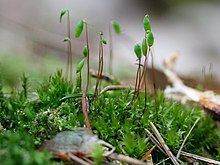Pohlia nutans
Appearance
| Pohlia nutans | |
|---|---|

| |
| Scientific classification | |
| Kingdom: | Plantae |
| Division: | Bryophyta |
| Class: | Bryopsida |
| Subclass: | Bryidae |
| Order: | Bryales |
| Family: | Mniaceae |
| Genus: | Pohlia |
| Species: | P. nutans
|
| Binomial name | |
| Pohlia nutans | |
| Synonyms[1] | |
|
List
| |
Pohlia nutans, the nodding thread-moss, is a species of moss in the family Mniaceae.[2] It has a Cosmopolitan distribution, found on all seven continents; Europe, Iceland, Siberia, Japan, North America, Greenland, the Andes of South America, South Africa, Tasmania and nearby mainland Australia, New Zealand, and the Antarctic Peninsula and Mount Rittmann in Antarctica.[1] An extremophile, it is resistant to cold, drought, salt, acid, heavy metals, and intense UV radiation.[3][4][5][6]
Pohlia nutans is subject to fungal infections which cause fairy rings to appear. Some causative agents have been identified, including species of Cladosporium, Mortierella gamsii and Mortierella fimbricystis.[7]
Subtaxa
The following subtaxa are accepted:[1]
- Pohlia nutans subsp. nutans (Hedw.) Lindb.
- Pohlia nutans subsp. otaruensis (Cardot) Ochi
- Pohlia nutans subsp. schimperi (Müll.Hal.) Nyholm
- Pohlia nutans f. angustiretis (H.Winter ex Broth.) Podp.
- Pohlia nutans f. arenaria (Mikut.) Podp.
- Pohlia nutans f. brevicuspidata (Roll) Podp.
- Pohlia nutans f. bryoides (Schiffner) Podp.
- Pohlia nutans f. compacta (Roll) Podp.
- Pohlia nutans f. cuspidatulum (Kindb.) Podp.
- Pohlia nutans f. decurtata (Warnst.) Podp.
- Pohlia nutans f. flagellata (Roll) Podp.
- Pohlia nutans f. gemmiclada (Schiffner) Podp.
- Pohlia nutans f. inclinata (Podp.) Podp.
- Pohlia nutans f. laxa (H.Winter) Podp.
- Pohlia nutans f. longicuspidata (Roll) Podp.
- Pohlia nutans f. microspora (Latzel) Podp.
- Pohlia nutans f. mollis (Warnst.) Podp.
- Pohlia nutans f. nutans
- Pohlia nutans f. patula (Loeske) E.Bauer
- Pohlia nutans f. pehrii (Latzel) Podp.
- Pohlia nutans f. prolifera (Warnst.) Podp.
- Pohlia nutans f. pseudocucullata (Limpr.) Podp.
- Pohlia nutans f. purpurascens (Latzel) Podp.
- Pohlia nutans f. ramosissima (Hamm.) Podp.
- Pohlia nutans f. robusta (Boulay) Podp.
- Pohlia nutans f. saltans (Loeske) Podp.
- Pohlia nutans f. stollei (Riehm.) Podp.
- Pohlia nutans f. teres (C.E.O.Jensen) Podp.
References
- ^ a b c GBIF Backbone Taxonomy. "Pohlia nutans Lindberg, 1879". gbif.org. GBIF Secretariat. Retrieved 1 January 2022.
- ^ Goffinet, B.; Buck, W. R. (31 March 2020). "Classification of extant moss genera". bryology.uconn.edu. University of Connecticut. Retrieved 1 January 2022.
- ^ Boulc'h, Pierre-Nicolas; Caullireau, Emma; Faucher, Elvina; Gouerou, Maverick; Guérin, Amandine; Miray, Romane; Couée, Ivan (2020). "Abiotic stress signalling in extremophile land plants". Journal of Experimental Botany. 71 (19): 5771–5785. doi:10.1093/jxb/eraa336. PMID 32687568.
- ^ Wang, Jing; Liu, Shenghao; Liu, Hongwei; Chen, Kaoshan; Zhang, Pengying (2019). "PnSAG1, an E3 ubiquitin ligase of the Antarctic moss Pohlia nutans, enhanced sensitivity to salt stress and ABA". Plant Physiology and Biochemistry. 141: 343–352. doi:10.1016/j.plaphy.2019.06.002. PMID 31207495. S2CID 190533214.
- ^ Munford, Kimber E.; Asemaninejad, Asma; Basiliko, Nathan; Mykytczuk, Nadia C. S.; Glasauer, Susan; McGarry, Samantha; Watmough, Shaun A. (2021). "Native plants facilitate vegetation succession on amended and unamended mine tailings". International Journal of Phytoremediation: 1–12. doi:10.1080/15226514.2021.1987382. PMID 34647850. S2CID 238858978.
- ^ Li, Chengcheng; Liu, Shenghao; Zhang, Wei; Chen, Kaoshan; Zhang, Pengying (2019). "Transcriptional profiling and physiological analysis reveal the critical roles of ROS-scavenging system in the Antarctic moss Pohlia nutans under Ultraviolet-B radiation". Plant Physiology and Biochemistry. 134: 113–122. doi:10.1016/j.plaphy.2018.10.034. PMID 30448024. S2CID 53947267.
- ^ Rosa, Luiz Henrique; Sousa, Jordana Rosa Paiva de; Menezes, Graciéle Cunha Alves de; Coehlo, Lívia da Costa; Carvalho-Silva, Micheline; Convey, Peter; Câmara, Paulo Eduardo Aguiar Saraiva (2020). "Opportunistic fungi found in fairy rings are present on different moss species in the Antarctic Peninsula". Polar Biology. 43: 587–596. doi:10.1007/s00300-020-02663-w.
